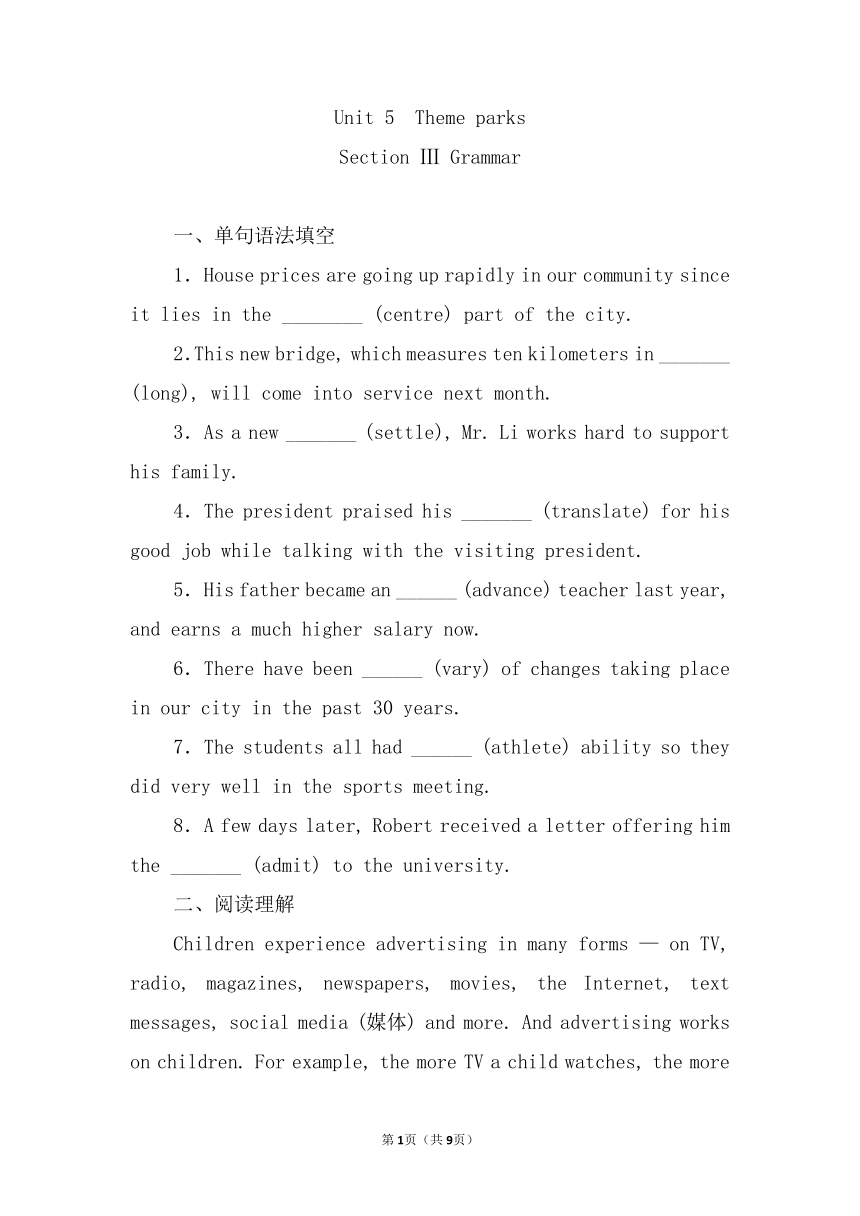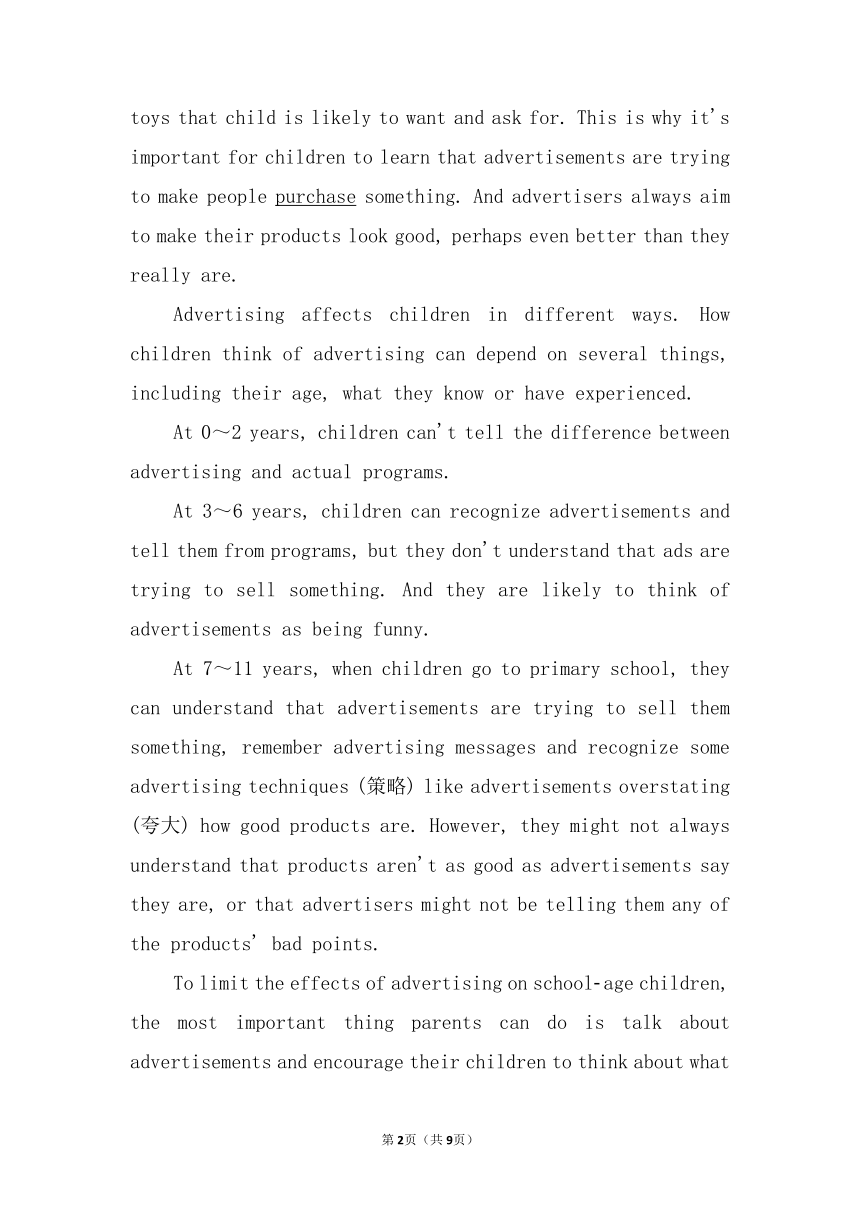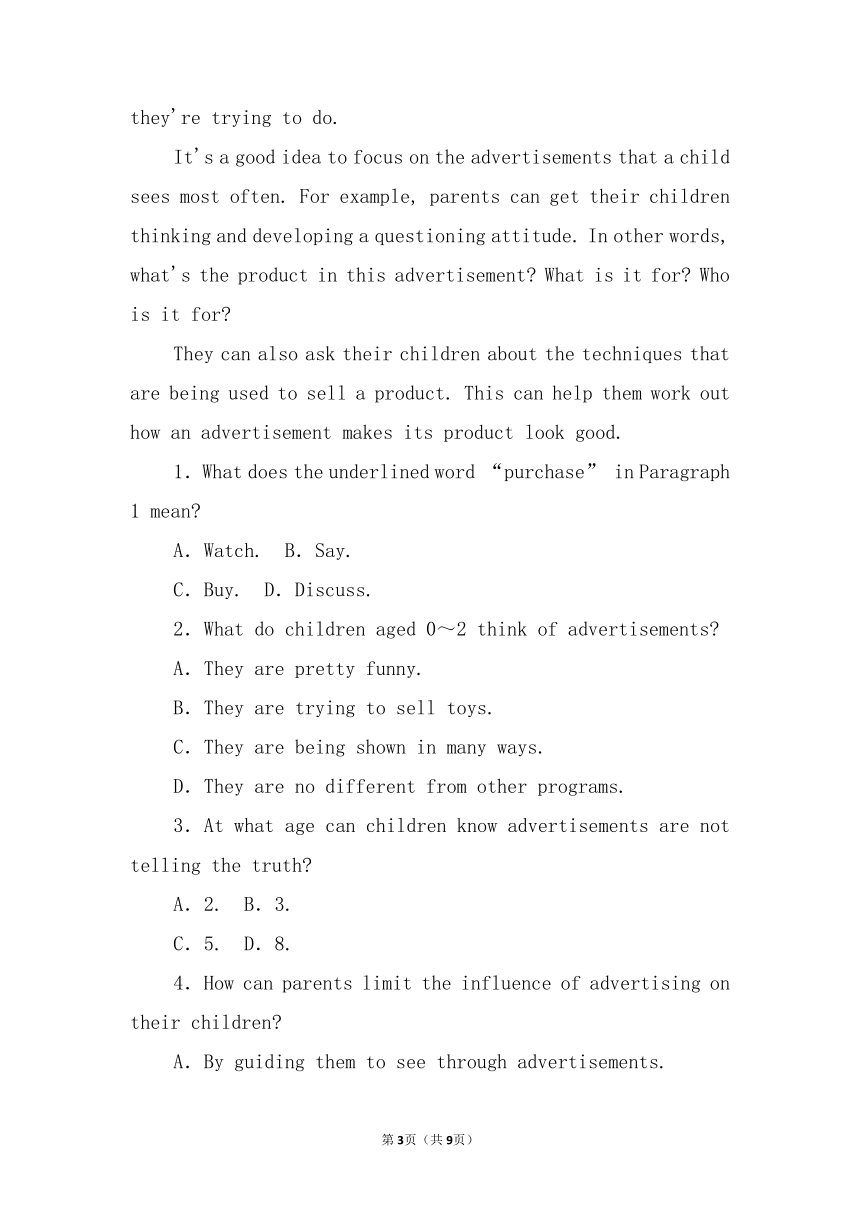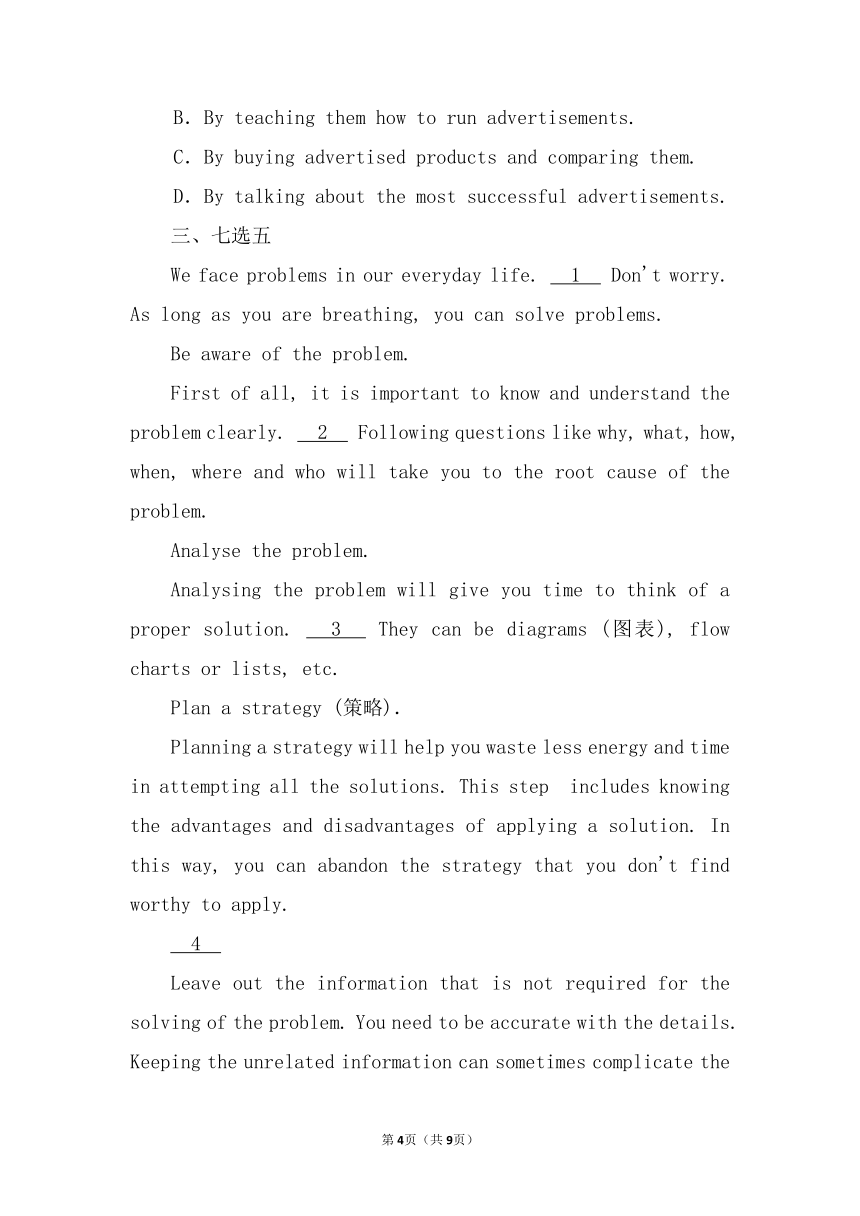人教版(新课程标准)必修四:Unit 5 Theme parks Grammar 课后强化提升练(含答案)
文档属性
| 名称 | 人教版(新课程标准)必修四:Unit 5 Theme parks Grammar 课后强化提升练(含答案) |  | |
| 格式 | doc | ||
| 文件大小 | 43.0KB | ||
| 资源类型 | 教案 | ||
| 版本资源 | 人教版(新课程标准) | ||
| 科目 | 英语 | ||
| 更新时间 | 2021-12-08 07:06:21 | ||
图片预览




文档简介
Unit 5 Theme parks
Section Ⅲ Grammar
一、单句语法填空
1.House prices are going up rapidly in our community since it lies in the ________ (centre) part of the city.
2.This new bridge, which measures ten kilometers in _______ (long), will come into service next month.
3.As a new _______ (settle), Mr. Li works hard to support his family.
4.The president praised his _______ (translate) for his good job while talking with the visiting president.
5.His father became an ______ (advance) teacher last year, and earns a much higher salary now.
6.There have been ______ (vary) of changes taking place in our city in the past 30 years.
7.The students all had ______ (athlete) ability so they did very well in the sports meeting.
8.A few days later, Robert received a letter offering him the _______ (admit) to the university.
二、阅读理解
Children experience advertising in many forms — on TV, radio, magazines, newspapers, movies, the Internet, text messages, social media (媒体) and more. And advertising works on children. For example, the more TV a child watches, the more toys that child is likely to want and ask for. This is why it's important for children to learn that advertisements are trying to make people purchase something. And advertisers always aim to make their products look good, perhaps even better than they really are.
Advertising affects children in different ways. How children think of advertising can depend on several things, including their age, what they know or have experienced.
At 0~2 years, children can't tell the difference between advertising and actual programs.
At 3~6 years, children can recognize advertisements and tell them from programs, but they don't understand that ads are trying to sell something. And they are likely to think of advertisements as being funny.
At 7~11 years, when children go to primary school, they can understand that advertisements are trying to sell them something, remember advertising messages and recognize some advertising techniques (策略) like advertisements overstating (夸大) how good products are. However, they might not always understand that products aren't as good as advertisements say they are, or that advertisers might not be telling them any of the products' bad points.
To limit the effects of advertising on school age children, the most important thing parents can do is talk about advertisements and encourage their children to think about what they're trying to do.
It's a good idea to focus on the advertisements that a child sees most often. For example, parents can get their children thinking and developing a questioning attitude. In other words, what's the product in this advertisement What is it for Who is it for
They can also ask their children about the techniques that are being used to sell a product. This can help them work out how an advertisement makes its product look good.
1.What does the underlined word “purchase” in Paragraph 1 mean
A.Watch. B.Say.
C.Buy. D.Discuss.
2.What do children aged 0~2 think of advertisements
A.They are pretty funny.
B.They are trying to sell toys.
C.They are being shown in many ways.
D.They are no different from other programs.
3.At what age can children know advertisements are not telling the truth
A.2. B.3.
C.5. D.8.
4.How can parents limit the influence of advertising on their children
A.By guiding them to see through advertisements.
B.By teaching them how to run advertisements.
C.By buying advertised products and comparing them.
D.By talking about the most successful advertisements.
三、七选五
We face problems in our everyday life. 1 Don't worry. As long as you are breathing, you can solve problems.
Be aware of the problem.
First of all, it is important to know and understand the problem clearly. 2 Following questions like why, what, how, when, where and who will take you to the root cause of the problem.
Analyse the problem.
Analysing the problem will give you time to think of a proper solution. 3 They can be diagrams (图表), flow charts or lists, etc.
Plan a strategy (策略).
Planning a strategy will help you waste less energy and time in attempting all the solutions. This step includes knowing the advantages and disadvantages of applying a solution. In this way, you can abandon the strategy that you don't find worthy to apply.
4
Leave out the information that is not required for the solving of the problem. You need to be accurate with the details. Keeping the unrelated information can sometimes complicate the simple problems as we tend to overlook the important information.
Carry out the solution.
Putting the solution into effect in a correct way to get the result expected is important while solving a problem. You need to be creative while actualizing (实施) a solution just in case some other problem arises while applying the solution. 5
A.Remove unrelated information.
B.You can use various tools to study the problem.
C.Use yes or no questions to get better information.
D.Knowing the problem means solving half the problem itself.
E.They can be social problems, relationship problems, or problems at work.
F.Being ready with alternatives is also important in case a solution works only halfway.
G.Spend 10% of the time analysing the problem and 90% on the solution, not the opposite.
四、语法填空
The Montreal Museum of Fine Arts in Canada has teamed up with a group of doctors 1.__________ (help) sick people.The doctors will send patients to art galleries,instead of 2.__________ (give) them medicine.The museum is taking part 3.__________ ten trials on patients to find out how art affects health.The patients include people with breast cancer (癌症),eating disorders and mental health problems.Thomas Bastien,4__________ (direct) of education and wellness at the museum,believes that art heals(治愈).He said,“We saw that the museum was good for people,so we 5.__________ (decide) to start this program with the doctors a few months ago.If you have breast cancer,you can come to the museum and you might feel much 6.__________ (well)”.
Dr Hélène Boyer,7.__________ has a lot of experience in helping to heal people with art therapy (疗法),spoke about its advantages.She said,“There’s more and more scientific evidence 8.__________ art therapy is good for your physical health.” She said looking at art increases the same kinds of hormones (激素) in 9.__________ (we) bodies that are produced when we exercise.The museum’s director general said,“I am 10.__________ (complete) sure that in the 21st century,art will be what physical activity was for health in the 20th century.”
一、单句语法填空
1.central
2.length
3.settler
4.translator
5.advanced
6.varieties
7.athletic
8.admission
二、阅读理解
1.C 词义猜测题。由第一段中的“For example, the more TV a child... want and ask for...”可知,孩子们电视看得越多,想要买的东西越多,那么作为父母应该让孩子知道广告的目的就是说服人们“购买”东西。
2.D 细节理解题。由第三段中的“At 0~2 years, children can't tell... actual programs...”可知,0~2岁的孩子认为广告和其他节目没有区别。
3.D 细节理解题。由第五段中的“... recognize some advertising techniques... good products are...”可知,7~11岁的孩子逐渐能够判断出广告中的内容有夸大成分,并非全部属实。
4.A 推理判断题。由倒数第二段中的“For example, parents can get their children... Who is it for...”可知,父母要引导孩子看清广告的真面目。
三、七选五
1.E 上一句说我们每天都在面对着各种问题,下文接着又说我们可以解决这些问题,综合比较各个选项可知,此处应该是对各种问题进行列举。故选E。
2.D 上一句说首先我们必须要非常清楚地了解问题,接下来就应该是说了解问题的重要性。由此可知,D选项符合题意。故选D。
3.B 根据下文中的举例“They can be diagrams (图表),flow charts or lists, etc.”可知这些都是分析问题的方法。故选B。
4.A 根据文中的“Leave out the information that is not required for the solving of the problem.”可知,要去除不需要的信息,而A选项是对这一句话的同义转述。故选A。
5.F 根据文中的“You need to be creative while actualizing (实施) a solution just in case some other problem arises while applying the solution.”可知,在施行解决方案时为了防止出现其他问题,我们必须要具有创造性。综合比较各个选项可知F选项符合题意。
四、语法填空
1.to help 考查不定式作状语的用法。设空处所在句意为“加拿大医生与蒙特利尔美术馆携手帮助病人”,故填to help。to help sick people在此作目的状语。
2.giving 考查动词 ing形式作宾语的用法。设空处作介词of的宾语,故填giving。
3.in 考查介词。take part in...意为“参与……”。
4.director 考查名词。设空处作同位语,表示“负责人”,故填director。
5.decided 考查一般过去时。由上文中的“The Montreal Museum of Fine Arts in Canada has teamed up with a group of doctors”以及本句中的“a few months ago”可知,设空处表示的动作发生在过去,应用一般过去时,故填decided。
6.better 考查形容词比较级。设空处所在句意为“如果你患有乳腺癌,那你可以来博物馆,你的病情可能会好转”,故填well的比较级better。
7.who 考查关系代词。设空处引导非限制性定语从句,指代Dr Hélène Boyer且在从句中作主语,故填who。
8.that 考查连接词。设空处引导同位语从句,解释说明evidence的具体内容,因为从句成分及意义均完整,故填that。
9.our 考查代词。设空处作定语修饰bodies,表示“我们的”,故填形容词性物主代词our。
10.completely 考查副词。设空处作状语修饰形容词sure,表示“十分地,完全地”,故填副词completely。
第10页(共10页)
Section Ⅲ Grammar
一、单句语法填空
1.House prices are going up rapidly in our community since it lies in the ________ (centre) part of the city.
2.This new bridge, which measures ten kilometers in _______ (long), will come into service next month.
3.As a new _______ (settle), Mr. Li works hard to support his family.
4.The president praised his _______ (translate) for his good job while talking with the visiting president.
5.His father became an ______ (advance) teacher last year, and earns a much higher salary now.
6.There have been ______ (vary) of changes taking place in our city in the past 30 years.
7.The students all had ______ (athlete) ability so they did very well in the sports meeting.
8.A few days later, Robert received a letter offering him the _______ (admit) to the university.
二、阅读理解
Children experience advertising in many forms — on TV, radio, magazines, newspapers, movies, the Internet, text messages, social media (媒体) and more. And advertising works on children. For example, the more TV a child watches, the more toys that child is likely to want and ask for. This is why it's important for children to learn that advertisements are trying to make people purchase something. And advertisers always aim to make their products look good, perhaps even better than they really are.
Advertising affects children in different ways. How children think of advertising can depend on several things, including their age, what they know or have experienced.
At 0~2 years, children can't tell the difference between advertising and actual programs.
At 3~6 years, children can recognize advertisements and tell them from programs, but they don't understand that ads are trying to sell something. And they are likely to think of advertisements as being funny.
At 7~11 years, when children go to primary school, they can understand that advertisements are trying to sell them something, remember advertising messages and recognize some advertising techniques (策略) like advertisements overstating (夸大) how good products are. However, they might not always understand that products aren't as good as advertisements say they are, or that advertisers might not be telling them any of the products' bad points.
To limit the effects of advertising on school age children, the most important thing parents can do is talk about advertisements and encourage their children to think about what they're trying to do.
It's a good idea to focus on the advertisements that a child sees most often. For example, parents can get their children thinking and developing a questioning attitude. In other words, what's the product in this advertisement What is it for Who is it for
They can also ask their children about the techniques that are being used to sell a product. This can help them work out how an advertisement makes its product look good.
1.What does the underlined word “purchase” in Paragraph 1 mean
A.Watch. B.Say.
C.Buy. D.Discuss.
2.What do children aged 0~2 think of advertisements
A.They are pretty funny.
B.They are trying to sell toys.
C.They are being shown in many ways.
D.They are no different from other programs.
3.At what age can children know advertisements are not telling the truth
A.2. B.3.
C.5. D.8.
4.How can parents limit the influence of advertising on their children
A.By guiding them to see through advertisements.
B.By teaching them how to run advertisements.
C.By buying advertised products and comparing them.
D.By talking about the most successful advertisements.
三、七选五
We face problems in our everyday life. 1 Don't worry. As long as you are breathing, you can solve problems.
Be aware of the problem.
First of all, it is important to know and understand the problem clearly. 2 Following questions like why, what, how, when, where and who will take you to the root cause of the problem.
Analyse the problem.
Analysing the problem will give you time to think of a proper solution. 3 They can be diagrams (图表), flow charts or lists, etc.
Plan a strategy (策略).
Planning a strategy will help you waste less energy and time in attempting all the solutions. This step includes knowing the advantages and disadvantages of applying a solution. In this way, you can abandon the strategy that you don't find worthy to apply.
4
Leave out the information that is not required for the solving of the problem. You need to be accurate with the details. Keeping the unrelated information can sometimes complicate the simple problems as we tend to overlook the important information.
Carry out the solution.
Putting the solution into effect in a correct way to get the result expected is important while solving a problem. You need to be creative while actualizing (实施) a solution just in case some other problem arises while applying the solution. 5
A.Remove unrelated information.
B.You can use various tools to study the problem.
C.Use yes or no questions to get better information.
D.Knowing the problem means solving half the problem itself.
E.They can be social problems, relationship problems, or problems at work.
F.Being ready with alternatives is also important in case a solution works only halfway.
G.Spend 10% of the time analysing the problem and 90% on the solution, not the opposite.
四、语法填空
The Montreal Museum of Fine Arts in Canada has teamed up with a group of doctors 1.__________ (help) sick people.The doctors will send patients to art galleries,instead of 2.__________ (give) them medicine.The museum is taking part 3.__________ ten trials on patients to find out how art affects health.The patients include people with breast cancer (癌症),eating disorders and mental health problems.Thomas Bastien,4__________ (direct) of education and wellness at the museum,believes that art heals(治愈).He said,“We saw that the museum was good for people,so we 5.__________ (decide) to start this program with the doctors a few months ago.If you have breast cancer,you can come to the museum and you might feel much 6.__________ (well)”.
Dr Hélène Boyer,7.__________ has a lot of experience in helping to heal people with art therapy (疗法),spoke about its advantages.She said,“There’s more and more scientific evidence 8.__________ art therapy is good for your physical health.” She said looking at art increases the same kinds of hormones (激素) in 9.__________ (we) bodies that are produced when we exercise.The museum’s director general said,“I am 10.__________ (complete) sure that in the 21st century,art will be what physical activity was for health in the 20th century.”
一、单句语法填空
1.central
2.length
3.settler
4.translator
5.advanced
6.varieties
7.athletic
8.admission
二、阅读理解
1.C 词义猜测题。由第一段中的“For example, the more TV a child... want and ask for...”可知,孩子们电视看得越多,想要买的东西越多,那么作为父母应该让孩子知道广告的目的就是说服人们“购买”东西。
2.D 细节理解题。由第三段中的“At 0~2 years, children can't tell... actual programs...”可知,0~2岁的孩子认为广告和其他节目没有区别。
3.D 细节理解题。由第五段中的“... recognize some advertising techniques... good products are...”可知,7~11岁的孩子逐渐能够判断出广告中的内容有夸大成分,并非全部属实。
4.A 推理判断题。由倒数第二段中的“For example, parents can get their children... Who is it for...”可知,父母要引导孩子看清广告的真面目。
三、七选五
1.E 上一句说我们每天都在面对着各种问题,下文接着又说我们可以解决这些问题,综合比较各个选项可知,此处应该是对各种问题进行列举。故选E。
2.D 上一句说首先我们必须要非常清楚地了解问题,接下来就应该是说了解问题的重要性。由此可知,D选项符合题意。故选D。
3.B 根据下文中的举例“They can be diagrams (图表),flow charts or lists, etc.”可知这些都是分析问题的方法。故选B。
4.A 根据文中的“Leave out the information that is not required for the solving of the problem.”可知,要去除不需要的信息,而A选项是对这一句话的同义转述。故选A。
5.F 根据文中的“You need to be creative while actualizing (实施) a solution just in case some other problem arises while applying the solution.”可知,在施行解决方案时为了防止出现其他问题,我们必须要具有创造性。综合比较各个选项可知F选项符合题意。
四、语法填空
1.to help 考查不定式作状语的用法。设空处所在句意为“加拿大医生与蒙特利尔美术馆携手帮助病人”,故填to help。to help sick people在此作目的状语。
2.giving 考查动词 ing形式作宾语的用法。设空处作介词of的宾语,故填giving。
3.in 考查介词。take part in...意为“参与……”。
4.director 考查名词。设空处作同位语,表示“负责人”,故填director。
5.decided 考查一般过去时。由上文中的“The Montreal Museum of Fine Arts in Canada has teamed up with a group of doctors”以及本句中的“a few months ago”可知,设空处表示的动作发生在过去,应用一般过去时,故填decided。
6.better 考查形容词比较级。设空处所在句意为“如果你患有乳腺癌,那你可以来博物馆,你的病情可能会好转”,故填well的比较级better。
7.who 考查关系代词。设空处引导非限制性定语从句,指代Dr Hélène Boyer且在从句中作主语,故填who。
8.that 考查连接词。设空处引导同位语从句,解释说明evidence的具体内容,因为从句成分及意义均完整,故填that。
9.our 考查代词。设空处作定语修饰bodies,表示“我们的”,故填形容词性物主代词our。
10.completely 考查副词。设空处作状语修饰形容词sure,表示“十分地,完全地”,故填副词completely。
第10页(共10页)
同课章节目录
